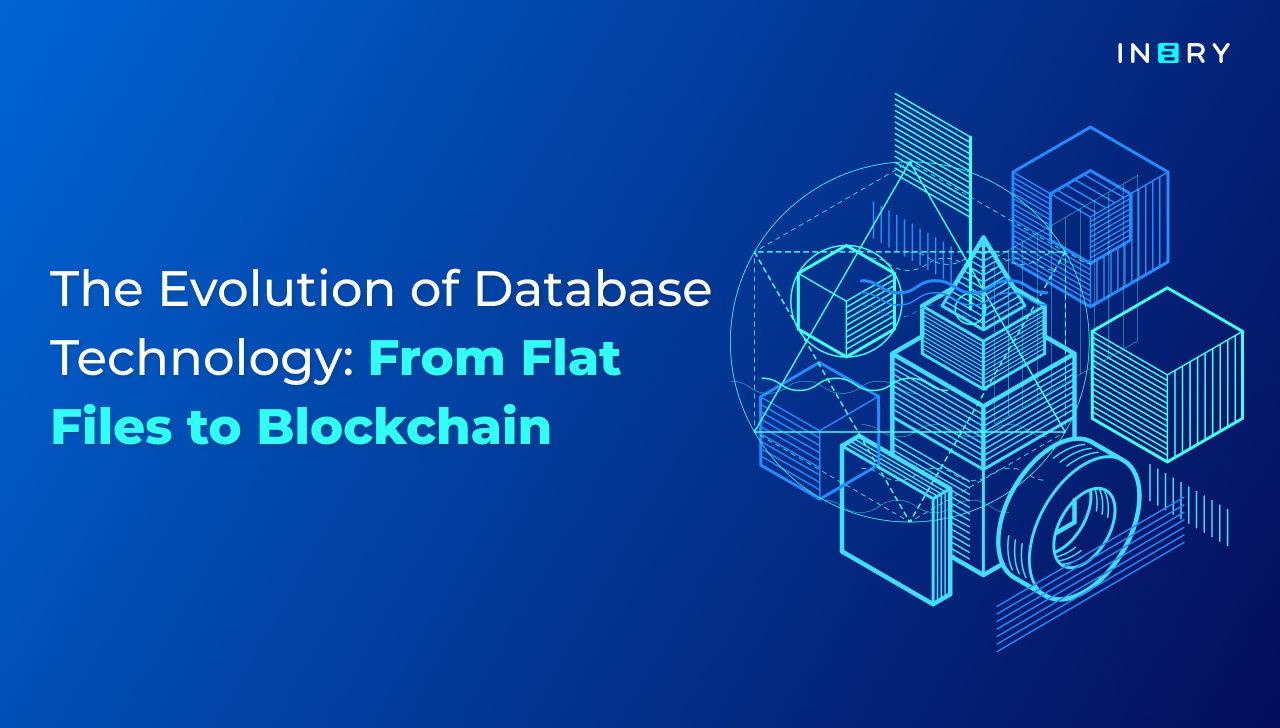Significant milestones have marked the evolution of database technology, each aimed at addressing the limitations of its predecessors and meeting the growing demands of data storage, retrieval, and security. From the rudimentary flat file systems to the cutting-edge blockchain databases, each stage in this evolution reflects the ongoing quest for efficiency, reliability, and innovation in data management.
In this blog post, we will explore the historical development of database technology, examine the challenges associated with centralized databases, and discuss how blockchain, particularly solutions like Inery, offers a modern and reliable alternative.
The Early Days: Flat File Systems
In the early days of computing, flat file systems were the standard for data storage. These systems utilized simple text files where each line represented a record, and fields within a record were separated by delimiters such as commas or tabs.
Flat file systems were straightforward to implement and use, making them popular in the 1960s and 1970s. However, as the volume of data grew, the limitations of flat file systems became increasingly apparent.
One major drawback was data redundancy and inconsistency. Since flat files did not enforce any structure, duplicate data entries were common, leading to inconsistencies. Additionally, there were no mechanisms to ensure data integrity, making the system prone to errors and corruption.
Scalability was another significant issue; as the dataset size increased, the performance of flat files deteriorated, making them inefficient for large-scale applications. Lastly, the lack of sophisticated querying capabilities made data retrieval cumbersome and slow.
The Rise of Relational Databases
The 1970s brought a revolutionary change with the advent of relational databases, primarily due to the pioneering work of Edgar F. Codd at IBM. Relational Database Management Systems (RDBMS) such as Oracle, IBM DB2, and later Microsoft SQL Server, introduced a structured approach to data management. These systems used tables to store data, with each table representing a different entity and rows within the table representing individual records.
The introduction of Structured Query Language (SQL) provided a powerful and flexible way to query and manipulate data. Normalization techniques helped in organizing data to reduce redundancy and improve data integrity. The ACID (Atomicity, Consistency, Isolation, Durability) properties ensured reliable transaction processing, making relational databases suitable for a wide range of applications.
Relational databases significantly improved data retrieval efficiency and consistency. They allowed for complex queries and supported large datasets and intricate relationships between different data entities. However, as data volumes continued to grow and the nature of data became more diverse, even relational databases faced challenges.
Their rigid schema structure made it difficult to handle unstructured data, and scaling them horizontally required significant effort and resources.
The Emergence of NoSQL Databases
To address the limitations of relational databases, NoSQL databases emerged in the late 2000s. NoSQL databases were designed to handle large volumes of unstructured data, support horizontal scaling, and provide high-speed transactions. These databases include various types such as document stores, key-value stores, column-family stores, and graph databases, each optimized for different use cases.
NoSQL databases offered schema flexibility, allowing for dynamic and evolving data models. This flexibility was particularly useful for applications dealing with diverse and rapidly changing data. Horizontal scalability was another significant advantage; NoSQL databases could scale out by adding more servers, making them ideal for large-scale applications. Additionally, they provided high performance for read and write operations, essential for real-time data processing.
Despite these advantages, NoSQL databases also had their share of challenges. Many NoSQL databases sacrificed data consistency for availability and partition tolerance, following the CAP theorem. Querying and managing NoSQL databases could be complex, requiring specialized knowledge. Furthermore, not all NoSQL databases fully support ACID transactions, which could be a limitation for applications requiring high levels of data integrity.
The Move to Blockchain Databases
As data management needs continued to evolve, the limitations of centralized databases became more pronounced. Centralized databases, whether relational or NoSQL, inherently possess a single point of failure, making them vulnerable to outages and attacks.
Centralized control also allows for potential data manipulation, posing security risks. The concentration of data in a single location makes it an attractive target for cyber-attacks, and the lack of transparency in data changes can lead to issues in auditing and trust.
Blockchain technology emerged as a promising solution to these challenges. Blockchain databases offer a decentralized approach to data management, distributing data across multiple nodes. This decentralization eliminates the single point of failure, enhancing resilience and availability.
The immutability of blockchain ensures that once data is written, it cannot be altered, providing a high level of data integrity. Transparency is another key feature; all transactions are recorded on a public ledger, making them fully traceable and auditable.
Blockchain databases use advanced cryptographic techniques to ensure data security and privacy. Each transaction is encrypted and linked to the previous one, forming a chain of blocks that is secure and tamper-proof. This makes blockchain databases ideal for applications requiring high levels of security and trust, such as financial services, healthcare, and supply chain management.
Inery: The Future of Database Technology
Inery is a blockchain-based database solution designed to address the critical challenges of centralized databases. By combining the best features of traditional databases with the innovative capabilities of lockchain, Inery offers a reliable and modern solution for data management.
Inery's decentralized infrastructure ensures data availability and resilience, eliminating the risks associated with single points of failure. Its smart contract functionality automates and enforces business logic with transparency and efficiency. Inery is optimized for high-speed transactions, making it suitable for real-time data processing applications.
Moreover, it offers seamless integration with existing systems, allowing organizations to transition to a decentralized model without disrupting their current operations.
The benefits of Inery extend to enhanced security, improved transparency, and greater resilience. Advanced cryptographic techniques protect data from unauthorized access and tampering, while the decentralized architecture ensures continuous availability even in the face of node failures.
Inery's smart contracts automate processes and enforce rules without the need for intermediaries, streamlining operations and reducing costs.
Conclusion
The evolution of database technology from flat files to blockchain represents a continuous effort to address the growing and changing needs of data management. While centralized databases have served us well, their inherent limitations are driving the adoption of decentralized solutions like blockchain.
Inery's blockchain-based database offers a promising future for secure, transparent, and resilient data management. By addressing the critical challenges of centralized databases, Inery is poised to lead the way in the next generation of database technology.

Inery•
1 week ago
Say Hello to IneryDB GUI Version 2.1!
Discover IneryDB GUI Version 2.1! This update features a powerful Multiformat Import Plugin for seamless data migrations from JSON, XML, and CSV formats, alongside enhanced user experience and front-end improvements. ...READ MORE

Share

Inery•
3 weeks ago
Data Privacy in the Age of Wearable Technology
Wearable technology brings convenience and connectivity, but also privacy risks. Discover how Inery addresses these challenges with innovative blockchain technology. ...READ MORE

Share

Inery•
1 week ago
The Intersection of IoT, AI, and Blockchain: Security and Efficiency
Uncover the synergy of IoT, AI, and Blockchain in enhancing security and efficiency. Delve into their history, importance, and how Inery pioneers this convergence for a connected future. ...READ MORE

Share

Inery•
2 years ago
Data Centralization: Feeding the Devil in Web 2.0
The grave repercussions when our data is controlled by a handful of entities ...READ MORE

Share
Most popular today



